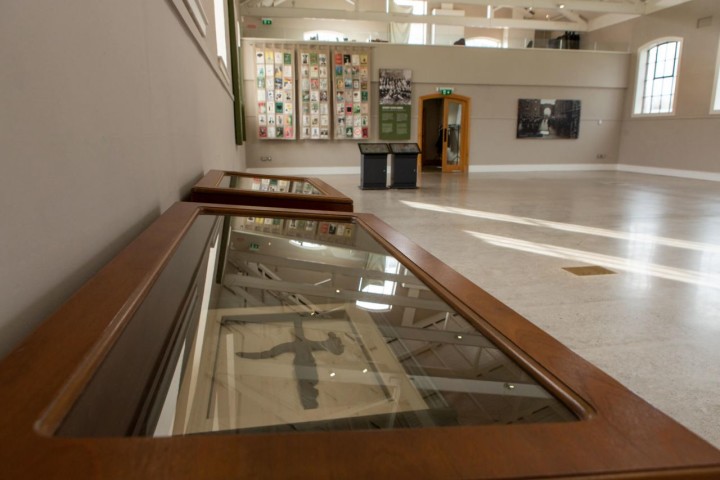


Richmond Barracks is delighted to welcome historian Donal Fallon to write a series of blog posts about the building and its rich history. Today, Donal is taking a look at a plaque on the wall of the gym in the Barracks.
A curious plaque on the wall of the Richmond Barracks gymnasium honours some of those detained at Richmond Barracks following the Rising.
The plaque, with its inscription only in Irish, lists the names of some who were detained here. The list of names is notable for including not only executed men, but other names such as Countess Markievicz. It also lists Noel Lemass, brother of the Taoiseach Seán Lemass, who died on the republican side of the Civil War, and W.T Cosgrave, first President of the Executive of the Irish Free State. In that sense, it is inclusive to both ‘traditions’ in the Civil War divide.
On first glance, many assume the plaque to date from the Golden Jubilee of the Rising in 1966. There was a flurry of commemoration and remembrance, not unlike the more recent centenary, with plaques across the city marking rebel garrisons and positions and memorials unveiled to some of the leaders of the Rising, not to mention renamed train stations, commemorative plaques and more besides.
A little digging reveals however that the plaque is not from the Golden Jubilee of the Rising, but rather the equivalent of St. Michael’s CBS school, which opened in the former Richmond Barracks in 1929. The plaque was unveiled by Liam Cosgrave, former Taoiseach, in 1979 at the celebration of the school. Liam Cosgrave had served as Taoiseach from 1973 until 1977. His government included future Taoiseach Garret Fitzgerald, who like him was the son of a 1916 veteran. Fitzgerald would succeed him as leader of the Fine Gael party in 1977.
Liam’s father had recounted his experiences of being detained at Richmond Barracks in his statement to the Bureau of Military History:
On arrival at Richmond Barracks some 60 of us were put into a barrack room in which there was no furniture and no ventilation. On opening the door in the morning the British Sergeant was almost overcome by the atmosphere. For breakfast a bucket containing tea and a basket with hard biscuit rations were brought in. The biscuits were tumbled out on the floor; empty corned-beef tins were used as tea-containers. Later, prisoners were marched to the gymnasium, placed on the righthand side of the room and told to sit down.
Cosgrave survived, but many of those he had fought beside were not so lucky. Both W.T Cosgrave and his son Liam are buried in Goldenbridge Cemetery, moments from Richmond Barracks. Their final resting place will feature on our forthcoming tours of the cemetery.
The plaque is noticeable also for the inclusion of a female participant in the Rising, in this case Constance Markievicz. Today she is honoured also with the installation ‘A Walk’ by artist Joanne Byrne, unveiled in 2019 by Lord Mayor Paul Mc Auliffe in the gardens of Richmond Barracks.
Donal Fallon is a historian, broadcaster and curator from Dublin. Formerly Historian in Residence to Dublin City Council, he is the author of numerous studies of twentieth century Dublin, including The Pillar: The Life and Afterlife of the Nelson Pillar (New Island, 2013). He produces the Three Castles Burning podcast and has contributed to publications including Jacobin, Dublin Historical Review, Saothar and The Irish Times. He is a graduate of Maynooth University, University College Dublin and the Ulster University, and lectures with the Lifelong Learning department of University College Dublin.
Posted 01 Bealtaine 2020
Tagged with: News